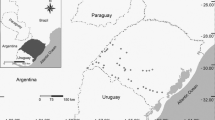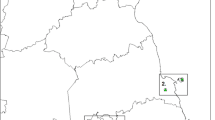Abstract
The European Beaver, once widely distributed across Europe, was almost completely eradicated in the nineteenth century. In the meantime, it has recovered large parts of its distribution range and has increasingly resettled the valleys of the Central European Highlands. In the past, in these same valleys, countless artificial fish and fire-fighting weir ponds, with a water regime similar in size and location to those of the Beaver, were created. In order to assess how near-natural the newt communities of the artificial ponds are, we studied 21 artificial and 22 Beaver ponds in the Eifel, a typical Central European Highland in Germany, using funnel traps. In general, artificial and Beaver ponds supported the same eight amphibian species, whereby the Beaver ponds had on average a larger number of species (4.8 species as opposed to 3.6). The average population size of the two dominant Urodela species, determined by a mark-recapture method, was higher than is usually recorded in other pond types, whereby the influence of the factor “Beaver” pond proved to be either neutral (Triturus alpestris) or positive (Triturus helveticus). The decisive factor for the activity density of both species in the ponds studied was the presence of fish. Artificial ponds probably provide an important substitute for the once common Beaver ponds for at least the majority of woodland species in large areas of Central Europe. This leads to the following conclusions:
-
(1)
The destruction of artificial weir ponds in line with the EU Water Framework Directive needs to be critically called into question to prevent avoidable damage to biodiversity.
-
(2)
Beaver ponds open undreamt opportunities for amphibian conservation in Europe. The Beaver should therefore be given special consideration and considered a key species for the preservation of biodiversity when preparing relevant EU programmes.



Similar content being viewed by others
References
Arens, P., T. van der Sluis, W. P. C. van’t Westende, B. Vosman, C. C. Vos & M. J. M. Smulders, 2007. Genetic population differentiation and connectivity among fragmented moor frog (Rana arvalis) populations in The Netherlands. Landscape Ecology 22: 1489–1500.
Aronsson, S. & J. A. E. Stenson, 1995. Newt–fish interactions in a small forest lake. Amphibia-Reptilia 16: 177–184.
Bender, O., J. H. Boehmer, D. Jens & K. P. Schumacher, 2005. Analysis of land-use change in a sector of Upper Franconia (Bavaria, Germany) since 1850 using land register records. Landscape Ecology 20: 149–163.
Becker, C. G., C. B. Fonseca, C. F. B. Haddad, R. F. Batista & P. I. Prado, 2007. Habitat split and the global decline of amphibians. Science 318: 1775–1777.
Berry, D. A., 1987. Logarithmic transformation in ANOVA. Biometrics 43: 439–456.
Bitz, A., K. Fischer & R. Thiele, 1996. Die rheinland-pfälzischen Biotoptypen und ihre Herpetofauna. In Bitz, A., K. Fischer, L. Simon, R. Thiele & M. Veith (eds), Die Amphibien und Reptilien in Rheinland-Pfalz, Vol. 2. Landau: 495–542.
Bosinski, G., 2006. Paläolithikum und Mesolihtikum im Rheinland. In Kunow, J. & H. H. Wegner (eds), Urgeschichte im Rheinland. Rheinischer Verein für Denkmalpflege und Landschaftsschutz 2005: 101–158.
Brandt, J. F. & J. T. C. Ratzeburg, 1829. Medizinische Zoologie oder getreue Darstellung und Beschreibung der Thiere, die in der Arzneimittellehre in Betracht kommen, in systematischer herausgegeben, Bd. I.– Akademie der Wissenschaften, Berlin: 12–29.
Breuer, P., 1992. Amphibien und Fische – Ergebnisse experimenteller Freilanduntersuchungen. Fauna, Flora Rheinland-Pfalz 6: 117–133.
Buskirk, J. V. & B. R. Schmidt, 2000. Predator-induced plasticity in larval newts: trade-offs, selection, and variation in nature. Ecology 81: 3009–3028.
Céréghino, R., J. Biggs, B. Oertli & S. Declerck, 2008a. The ecology of European ponds: defining the characteristics of a neglected freshwater habitat. Hydrobiologia 597: 1–6.
Céréghino, R., A. Ruggiero, P. Marty & S. Angélibert, 2008b. Biodiversity and distribution patterns of freshwater invertebrates in farm ponds of a south-western French agricultural landscape. Hydrobiologia 597: 43–51.
Cunningham, J. M., A. J. K. Calhoun & W. E. Glanz, 2007. Pond-breeding amphibian species richness and habitat selection in a beaver-modified landscape. Journal of Wildlife Management 71: 2517–2526.
Cushman, S. A., 2006. Effects of habitat loss and fragmentation on amphibians: a review and prospectus. Biological Conservation 128: 231–240.
Dalbeck, L., M. Hachtel, A. Heyd, K. Schäfer, M. Schäfer & K. Weddeling, 1997. Amphibien im Rhein-Sieg-Kreis und in der Stadt Bonn: Verbreitung, Gewässerpräferenzen, Vergesellschaftung und Gefährdung. Decheniana 150: 235–292.
Dalbeck, L., B. Lüscher & D. Ohlhoff, 2007. Beaver ponds as habitat of amphibian communities in a central European highland. Amphibia-Reptilia 28: 493–501.
Declerck, S., T. De Brie, D. Ercken, H. Hampel, S. Schrijvers, J. Van Wilchelen, V. Gillard, R. Mandiki, B. Losson, D. Bauwens, S. Keijers, W. Vyverman, B. Goddeeris, L. De Meester, L. Brendonck & K. Martens, 2006. Ecological characteristics of small farmland ponds: associations with land use practices at multiple spacial scales. Biological Conservation 131: 523–532.
Denoël, M. & G. F. Ficetola, 2007. Landscape-level thresholds and newt conservation. Ecological Applications 18: 714–728.
Denoël, M. & G. F. Ficetola, 2008. Conservation of newt guilds in an agricultural landscape of Belgium: the importance of aquatic and terrestrial landscapes. Aquatic Conservation: Marine and Freshwater Ecosystems: www.interscience.wiley.com. doi:10.1002/ac.853.
Drews, R. & H. P. Ziemek, 1995. Kleingewässerkunde. Wiesbaden: 146 pp.
Elmeros, M., A. B. Madsen & P. Berthelsen, 2003. Monitoring of reintroduced Beavers (Castor fiber) in Denmark. Lutra 46: 153–162.
Feldmann, R. & A. Belz, 1981. Bergmolch – Triturus alpestris (Laurenti 1768). In Feldmann, R. (ed.), Die Amphibien und Reptilien Westfalens. Abhandlungen des Landesmuseums für Naturkunde Münster 43: 45–54.
Gerlach, R., 2005. Holozän: Die Umgestaltung der Landschaft durch den Menschen seit dem Neolithikum. Rheinischer Verein für Denkmalpflege, Jahrbuch 2005: 87–98.
Han, M., M. Fukushima, S. Kameyama, T. Fukushima & B. Matsushita, 2007. How do dams affect freshwater fish distributions in Japan? Statistical analysis of native and nonnative species with various life histories. Ecological Research 23: 735–743.
Hecnar, S. J. & R. T. M’Closkey, 1997. The effects of predatory fish on amphibian species richness and distribution. Biological Conservation 79: 123–131.
Hecnar, S. J. & R. T. M’Closkey, 1998. Species richness patterns of amphibians in southwestern Ontario ponds. Journal of Biogeography 25: 763–772.
Heidecke, D. & B. Klenner-Frings, 1992. Studie über die Habitatnutzung des Bibers in der Kulturlandschaft und anthropogene Konfliktbereiche. 2nd international Symposium Semiaquatische Säugetiere, Osnabrück. Wissenschaftliche Beiträge der Universität Halle: 215–265.
Henle, K., 2000. Fang-Wiederfang-Methoden: Generelle Grundlagen, historische Entwicklung und aktueller Entwicklungsstand. Beiträge zur Ökologie 4: 1–132.
Hehmann, F. & H. Zucchi, 1985. Fischteiche und Amphibien–eine Feldstudie. Natur und Landschaft 10: 402–408.
Jakobus, M., 1986. Experimentelle Untersuchungen zur Amphibienmortalität durch Fischfraß. Schriftenreihe Bayrisches Landesamt für Umweltschutz 73: 211–214.
Johansson, M., C. R. Primmer & J. Merilä, 2007. Does habitat fragmentation reduce fitness and adaptability? A case study of the common frog (Rana temporaria). Molecular Ecology 16: 2693–2700.
Joy, M. K. & R. G. Death, 2001. Control of freshwater fish and crayfish community structure in Taranaki, New Zealand: dams, diadromy of habitat structure? Freshwater Biology 46: 417–429.
Krone, A., 2003. Kleingewässer und ihre Bedeutung für den Schutz von Amphibien. Jahresschrift für Feldherpetologie 7: 26–35.
Mazerolle, M. J., 2006. Improving data analysis in herpetology: using Akaike’s Information Criterion (AIC) to assess the strength of biological hypotheses. Amphibia-Reptilia 27: 169–180.
Meuerers-Balke, J. & A. J. Kalis, 2005. Landwirtschaft und Landnutzung in der Bronze- und Eisenzeit. Rheinischer Verein für Denkmalpflege, Jahrbuch 2005: 267–275.
Mitchell, S. C. & R. A. Cunjak, 2007. Stream flow, salmon and beaver dams: roles in the structuring of stream fish communities within an anadromous salmon dominated stream. Journal of Animal Ecology 76: 1062–1074.
Oertli, B., D. Auderset Joyse, E. Castella, R. Juge, D. Cambin & J.-B. Lachavanne, 2002. Does size matter? The relationship between pond area and biodiversity. Biologial Conservation 104: 59–70.
Oertli, B., J. Biggs, R. Céréghino, P. Grillas, P. Joly & J.-B. Lachavanne, 2005. Conservation and monitoring of pond biodiversity: introduction. Aquatic Conservation: Marine and Freshwater Ecosystems 15: 535–540.
Ortmann, D., M. Hachtel, U. Sander, P. Schmidt, D. Tarkhnishvili, K. Weddeling & W. Böhme, 2006. Capture effectiveness of terrestrial drift fences and funnel traps for the Great Crested Newt, Triturus cristatus. Proceedings of the 13th Ordinary General Meeting of the Societas Europaea Herpetologica: 103–105.
Robson, B. & C. J. Clay, 2005. Local and regional macroinvertebrate diversity in the wetlands of a cleared agricultural landscape in south-western Victoria, Australia. Aquatic conservation: Marine and Freshwater Ecosystems 15: 403–414.
Rolauffs, P., D. Hering & S. Lohse, 2001. Composition, invertebrate community and productivity of a Beaver dam in comparison to other stream habitat types. Hydrobiologia 459: 201–212.
Rosell, F., O. Bozsér, P. Collen & H. Parker, 2005. Ecological impact of Beavers Castor fiber and Castor canadensis and their ability to modify ecosystems. Mammal Review 35: 248–276.
Safonov, V.G., & A. P. Safeljev, 1992. Ökologische Besonderheiten der östlichen Population des Bibers Castor fiber L. in Eurasien.– Semiaquatische Säugetiere, wissenschaftliche Beiträge der Universität Halle: 2. Internationales Symposium Semiaquatische Säugetiere, Osnabrück: 157–167.
Schadewinkel, R., 2006. Populations- und Habitatanalyse für den Biber (Castor fiber) im Wassereinzugsgebiet der Rur. Säugetierkundliche Informationen 32: 623–647.
Schlüpmann, M., R. Günther & A. Geiger, 1996. Fadenmolch – Triturus helveticus (Razoumowsky, 1789). In Günther, R. (ed.), Die Amphibien und Reptilien Deutschlands: Gustaf Fischer, Jena: 143–174.
Smith, M. A. & D. M. Green, 2005. Dispersal and the metapopulation paradigm in amphibian ecology and conservation: are all amphibian populations metapopulations? Ecography 28: 110–128.
Stevens, C. E., C. A. Paszowski & G. J. Scrimgeour, 2006. Older is better: Beaver ponds on boreal streams as breeding habitat for the wood frog. Journal of Wildlife Management 70: 1360–1371.
Tockner, K., I. Klaus, C. Baumgartner & J. V. Ward, 2006. Amphibian diversity and nestedness in a dynamic floodplain river (Tagliamento, NE-Italy. Hydrobiologia 565: 121–133.
Watters, G. T., 1996. Small dams as barriers to freshwater mussels (Bivalvia, Unionida) and their hosts. Biological Conservation 75: 79–85.
Zehlius, J., L. Dalbeck, M. Hachtel & D. Ohlhoff, 2001. Die Amphibien und Reptilien im Kreis Euskirchen. Schriftenreihe der Biologischen Station im Kreis Euskirchen 3: 1–152.
Acknowledgements
The completion of this study would not have been possible without the support of many people. We were assisted in our field work by Beatrice Lüscher, Monika Hachtel, Klaus Weddeling and Alexander Heyd, Dieter Fink provided us with previously unpublished results and the manuscript was translated into English by David Conlin. We are grateful to all of the above for their contributions.
Author information
Authors and Affiliations
Corresponding author
Additional information
Handling editor: B. Oertli
Rights and permissions
About this article
Cite this article
Dalbeck, L., Weinberg, K. Artificial ponds: a substitute for natural Beaver ponds in a Central European Highland (Eifel, Germany)?. Hydrobiologia 630, 49–62 (2009). https://doi.org/10.1007/s10750-009-9779-8
Received:
Revised:
Accepted:
Published:
Issue Date:
DOI: https://doi.org/10.1007/s10750-009-9779-8




